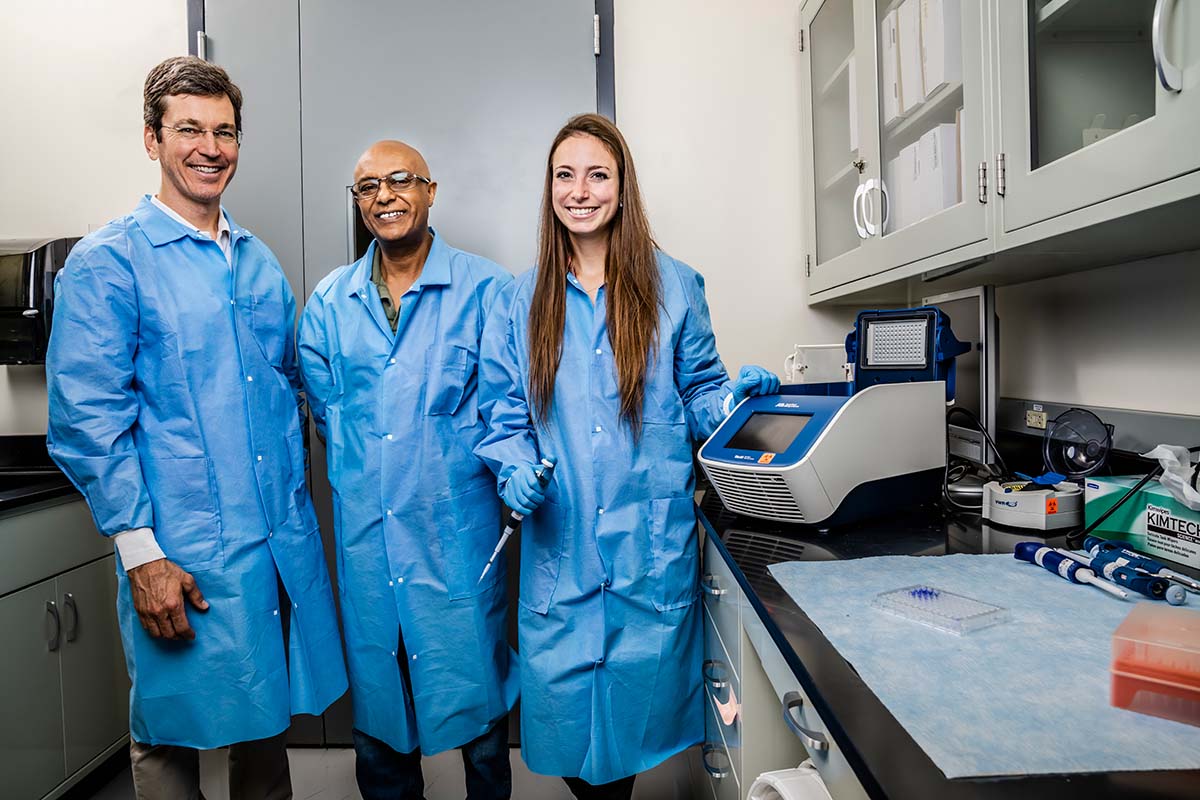Press Release
Johns Hopkins APL Paves the Way for Rapid, On-the-Spot Testing for Emergent Pathogens
Timely, accurate diagnosis is at the heart of an effective response to any emergent infectious threat. However, timeliness is a difficult bar to clear when testing requires that results be sent off to a lab for analysis. Accuracy is often the first casualty of quick results, such as with antigen tests and rapid polymerase chain reaction (PCR) tests that are not performed by trained professionals. In an effort to change that, scientists at the Johns Hopkins Applied Physics Laboratory (APL) looked at the problem a different way.
The goal was to create a foolproof, accurate, on-the-spot test for detecting RNA viruses — one that could even be used at home. The method focused on not creating anything new, and instead using mature, off-the-shelf technology.
“This is a key problem; if you ask anyone who works in diagnostics, they will tell you they want a sensitive and portable product,” says Mekbib Astatke, a biochemist in APL’s Asymmetric Operations Sector. “You either have to invent a disruptive technology to address it, or you can take a couple of mature products and marry them to get there. My argument has always been that it’s better to get mature products and use a systems integration approach, and then you can potentially leapfrog the problem.”
That is exactly what Astatke did. In collaboration with Olivia Tiburzi, a biotechnologist, and Amy Connolly, former APL scientist, the team combined two well-established technologies to prove the feasibility of a simple, quick, yet highly accurate test capable of detecting multiple known pathogens from a single liquid sample. The team’s work was recently published in the Journal of Immunoassay and Immunochemistry.
The first piece of the puzzle was nucleic acid sequence-based amplification (NASBA), a highly sensitive technique for detecting and amplifying RNA that has been around since the early 1990s. Unlike PCR, which amplifies DNA or RNA in a sample, NASBA only targets RNA. This provides a couple of key advantages. First, because RNA is far less stable than DNA, its presence is far more likely to be indicative of an active infection. Second, the PCR process requires DNA to be melted to yield a single RNA strand, which then must be quickly cooled to be analyzed; but because NASBA works directly with RNA, this additional step is not necessary and neither is the thermocycler needed to perform it.
The second piece is lateral flow tests (LFTs), which capture target molecules in a substance and produce a visual signal indicating their presence or absence (similar to home pregnancy tests). Combined with the versatility and specificity of NASBA, the result could very well be a home test for a disease such as COVID-19 — not to mention Zika, Ebola or any other RNA virus.
“The advantage of targeting RNA is that even bacteria has RNA in multiple copies,” Astatke said. “Every living thing has RNA.”
Given the genome of the target pathogen, it is then possible to design a primer enzyme specific to that pathogen that will bind to the RNA in the sample. This produces an intermediate molecule, an RNA-DNA hybrid with DNA specific to the target pathogen. A second enzyme then cleaves away the RNA from that hybrid, leaving behind a strand of DNA that is complementary to the viral RNA of the target. Finally, a third enzyme creates RNA complementary to that DNA, making copies, or amplicons, of the target viral RNA — a lot of copies, on the order of 10 billion for every 10 strands of viral RNA in the original sample.
For a detailed breakdown of how the assay works, see this infographic.
“One of the great things about this platform is the specificity that occurs during the amplification process,” Tiburzi explained, hitting on a key issue for other methods, such as PCR. “You’re not going to see as many false positives.”
An LFT using NASBA could even be used to test for an entire panel of pathogens in a single sample. It’s possible, even trivial, to “tag” a membrane with small identifier molecules, called haptens, specific to a certain pathogen. A single membrane can be tagged with multiple haptens, creating a distinct line as a visual signal for each target pathogen. The same process has been used commercially for years, in an FDA-approved assay for HPV.
While the concept has been proven in principle, it still faces challenges in implementation. Rather than using an LFT directly, the team used a technique called enzyme-linked immunosorbent assay (ELISA).
“ELISA and lateral flow use the exact same principle, so if a test is designed for one, it can work for the other,” Tiburzi said. “But it’s more difficult to implement a lateral flow design in practice.”
To overcome this problem, Astatke and Tiburzi teamed up with Stergios Papadakis and former colleague Konstantinos Gerasopoulos in APL’s Research and Exploratory Development Department to see whether the test could be implemented using a paper microfluidics system. Thus far, they have demonstrated that NASBA can work with a paper system but have not yet integrated the LFT component into the paper system. Such an implementation would make for an inexpensive test that could be made widely available — a vital piece of future efforts to combat emergent diseases, Astatke believes.
“Emerging diseases are usually RNA viruses. They’re influenza-based, like avian flu, Zika, Ebola, Lassa, dengue or COVID,” Astatke said. “When the next one comes, if you have this kind of easy platform to distribute to the wider population, then you have a better chance to contain it.”
